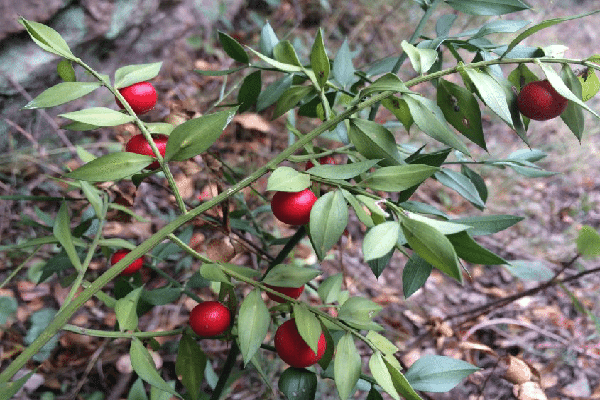Ruscus specifications
-
Scientific name : Ruscus
- Common Name : Butcher’s broom, horse tongue lily
- Order : Asparagales
- Family : Asparagaceae
- Subfamily : Nolinoideae
- Genus : Ruscus
- Species : R. aculeatus
- Native Areas : Africa, Asia, Europe, Eurasia
- Height : 2.00 to 3.00 feet
- Spread : 2.00 to 3.00 feet
- Bloom Time : April to May
- Bloom Description : Greenish-white
- Sun : Part shade to full shade
- Water : Medium
- Maintenance : Low
- Flower : Insignificant
- Leaf : Evergreen
- Fruit : Showy
- Tolerate : Drought, Heavy Shade
The Ruscus genus comprises roughly seven different species of flowering plants. The term Ruscus is derived from an old Latin term meaning “prickly plants.” One of the more widely-known varieties, Ruscus aculeatus, is known by the common name Butcher’s broom. Ruscus plants are related to both lilies and asparagus, though they really has very little else in common with those plants. Depending on the species, Ruscus plants have wide-ranging origins including northern Africa, Asia, and Europe.
read more : Everything about lunaria plant : How to Plant & care for lunaria

The bright green leaves and red berries of Ruscus create vibrant color in winter, making it a desirable landscape plant. It grows well in shady wooded areas and adds a bit of color to the woodland garden. Some varieties are rounded and compact, some erect and a bit taller, while others have a spreading habit.
Types of Ruscus
Ruscus comprises a large genus of similar plants; the seven different species in this genus are as follows:
-
Ruscus asculeatus
This variety is widely known as Butcher’s broom, and is native to Eurasia. It tolerates deep shade and is often found growing in woodlands. The flowers are white touched with purple. These evergreen shrubs can grow up to 3 feet tall. This variety is the most common source of the cultivars most often grown in the USA.
-
Ruscus colchicus
This type is native to Caucasus and is found in mountainous regions there.
read more : Everything about palm plant : How to Plant & care for palm
-
Ruscus hypoglossum
This variety is native to central and southeast Europe and Turkey. It is also known by the common folk names of Spineless butcher’s broom, Mouse thorn, and Horse tongue lily. It grows about 18 inches high and has small yellow flowers. The leaves are flattened and somewhat smoother and less prickly than other varieties.
-
Ruscus hypophyllum
Native to Iberia and northwest Africa. Another version of Spineless butcher’s broom. This one is often used in the floral trade as foliage.
-
Ruscus hyrcanus
This variety is native to Crimea, Iran, and Armenia. It has a compact shape and grows to a maximum height of about 20 inches. It is known for its many prickly branches and is considered a somewhat-endangered native plant species to be protected in Azerbaijan.
-
Ruscus microglossus
This variety is native to southern Europe.
-
Ruscus streptophyllus
This variety is native to Madeira. There are also a few different cultivars available for home gardens. Unless noted, all of these require both male and female plants for pollination and berry production, similar to holly and yew shrubs.
-
John Redmond
This has very glossy red berries and is a nice choice for winter interest and attracting songbirds. It has a spreading growth habit.
read more : Everything about needle grasses ( stipa ) : How to Plant & care for needle grasses
-
Christmas Berry
As its name suggests, this one produces an impressive display of brightly colored berries that remain through the winter season. It tends to be slower-growing than other varieties.
-
Wheeler’s Variety
This one is hermaphroditic, which means it self-pollinates, can be planted on its own, and will still produce berries.
-
Sparkler
This popular creeping variety is an effective ground cover and produces an abundance of red-orange berries.
-
Elizabeth Lawrence
Also hermaphroditic, this compact variety has erect stems that produce large red berries.
Ruscus Care
Ruscus is a fairly low-maintenance plant and establishes easily in the right conditions. It isn’t bothered by pests or diseases, and deer leave it alone. Birds are attracted to the berries in winter, and some may perch within the prickly leaves for protection from wind and safety from predators.
-
Light
Ruscus thrives in full or partial shade, and because it is drought-tolerant, will do well in your dry shade areas. If it gets too much sun in hot weather, the color may fade.
read more : Everything about pyracantha : How to Plant & care for pyracantha
-
Soil
This plant is tolerant of many soil types, including clay or alkaline soils. Its preferred soil culture is a well-drained, slightly acidic sandy loam. It does not do well in wet soils as this can cause the roots to rot over time.
-
Water
Although Ruscus is known to be very drought-tolerant, regular doses of rain keep the foliage looking vibrant. If there is a long period of hot dry weather and the foliage begins to fade, deep watering every three days or so will help revive it.
-
Temperature and Humidity
Ruscus is generally only cold-hardy to zone 6 in the U.S. If grown in a place with harsh winters, planting near a structure for wind protection is a good idea. Ruscus enjoys warm temperatures and does fine in humidity.
Iran dried ruscus leaves
Dried ruscus leaves originally came from Italy. If you want to create a dreamy atmosphere, the use of dried ruscus is highly recommended. These dried leaves, while beautiful, is completely recyclable in nature and will always look beautiful in your space without being destroyed. ruscus, in addition to its decorative aspect, is also used in cosmetics. The reasonable price of dried ruscus leaves has made the sale and purchase of dried ruscus plants a great profit for the exporters and wholesalers of dried rascus plants .
read more : Drying natural flowers | Introducing 8 wonderful ways to dry flowers

Dried ruscus leaves
Pruning
Being a slow-growing and well-shaped perennial, the ruscus doesn’t require much pruning. Damaged branches or leaves should be trimmed as needed. Dead shoots should be cut to ground level in spring.
Propagating Ruscus
Seeds can be harvested from female plants. They need a period of cold stratification before planting in late winter or early spring. Grow them in a sunny window or greenhouse, making sure they receive adequate water. They may also benefit from some soil nutrients every other month.
The germination for the ruscus is extremely slow, and can take up to 12 months. Once seedlings appear, grow them in containers for another year before planting outside. The young plants may be susceptible to slug damage, but once they mature and grow a prickly surface, slugs will leave them alone.
read more : Everything about pampas grass : How to Plant & care for pampas
How to Get Ruscus to Bloom
The plant bears flowers in late winter and these appear in the middle of the leaf instead of a stem. Flower color can also vary, from white to greenish-white to purple to yellow, although in general, the flowers are not showy on this plant, and the red berries are the main source of visual interest.
Some varieties require pollination to produce berries, and some do not; the female plants produce berries, but hermaphroditic plants will also produce them. The berries grow in clusters, or sometimes singly, and are round with a slightly flattened top and bottom.
How to propagate Ruscus
- Division : Divide clumps in spring.
- Seed : Sow seed as soon as ripe in sandy soil mix. Keep moist.
Notice : this article has been translated by google translate , if you have any questions or need more information Please contact us by writing a comment on this page.



0 Comments